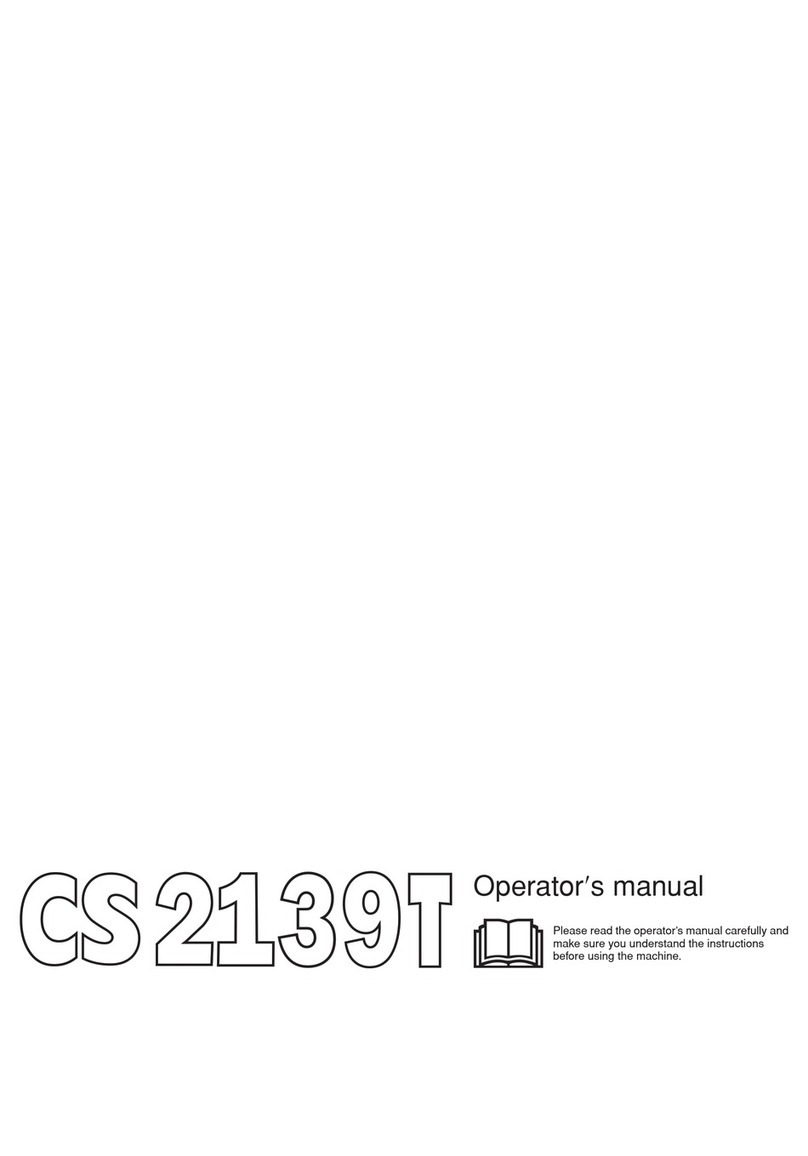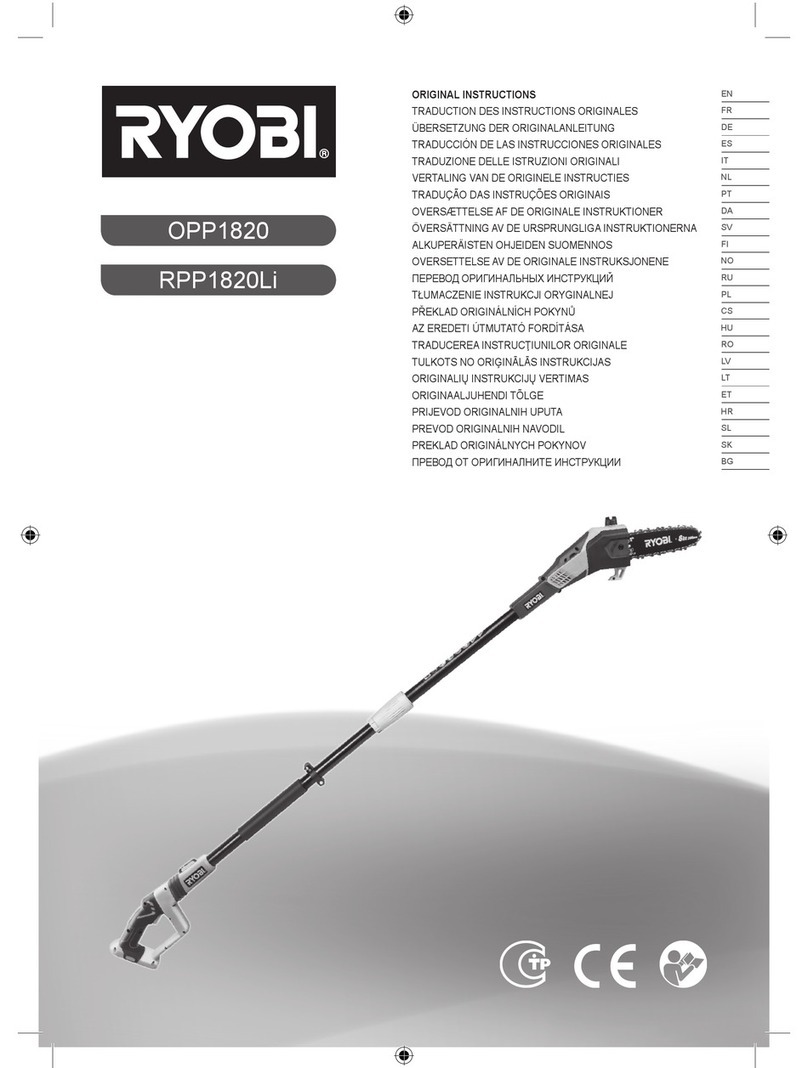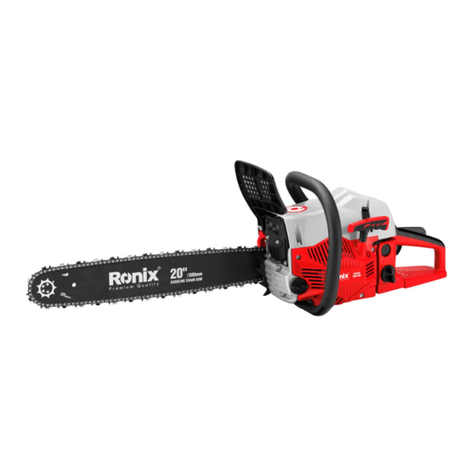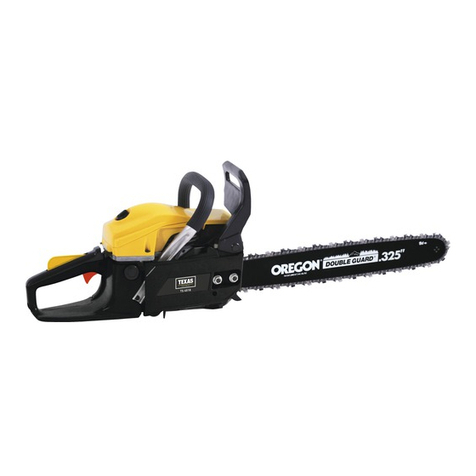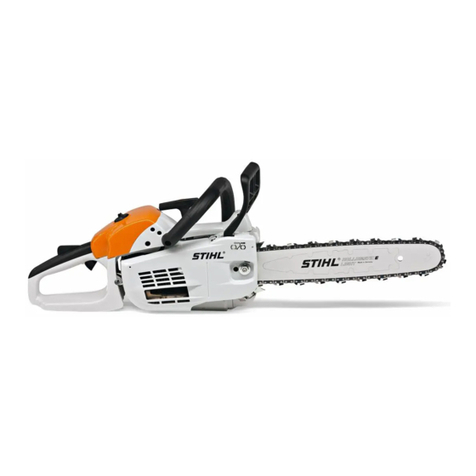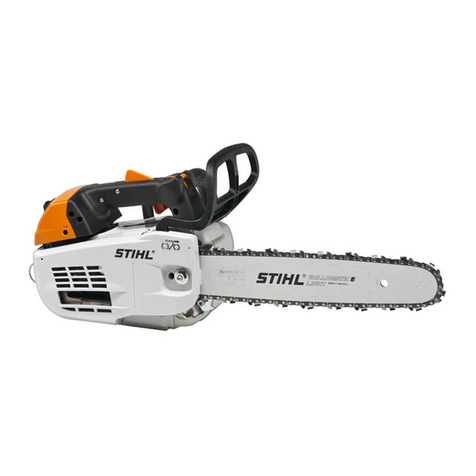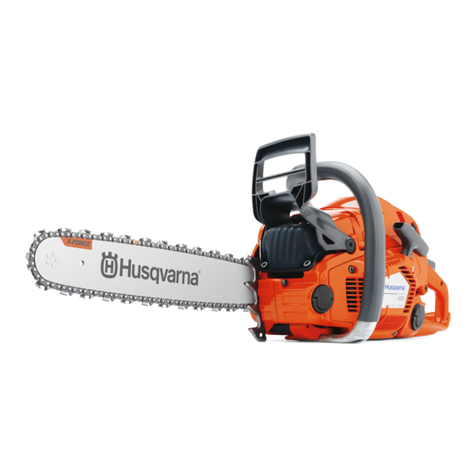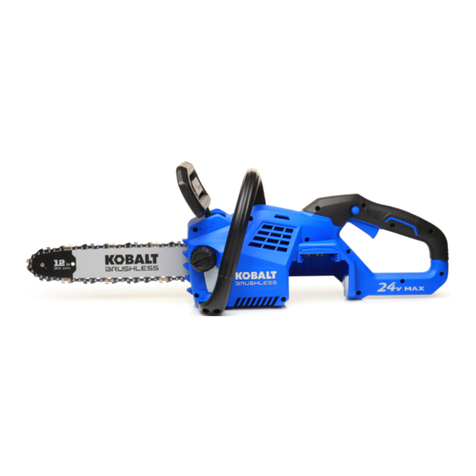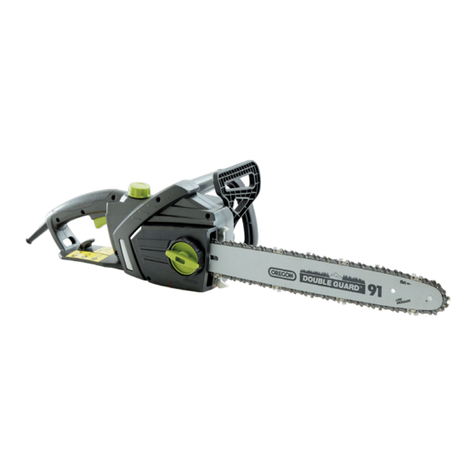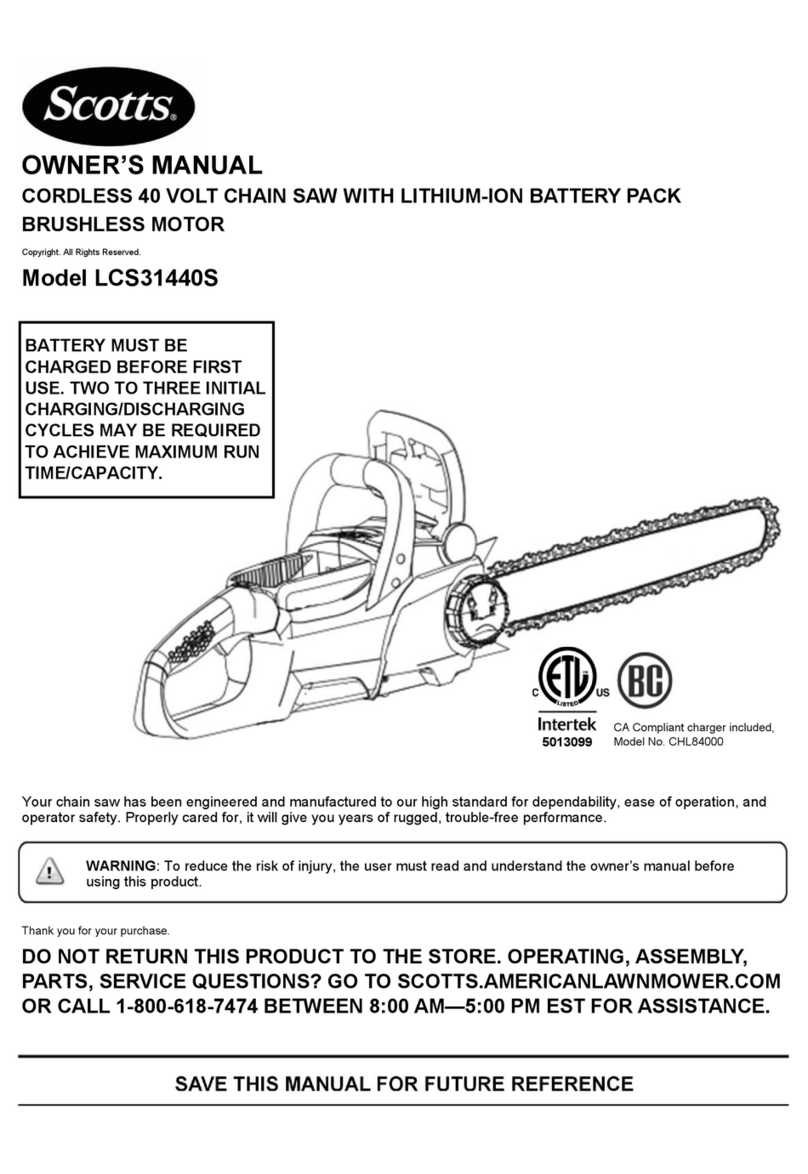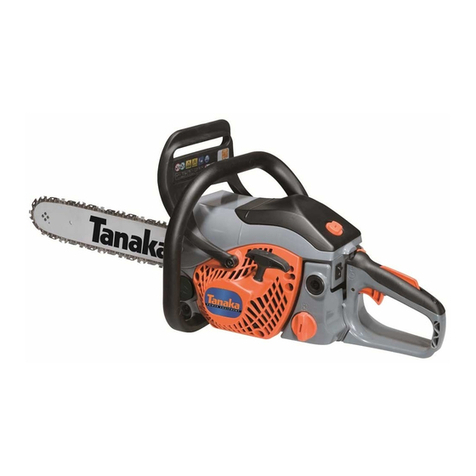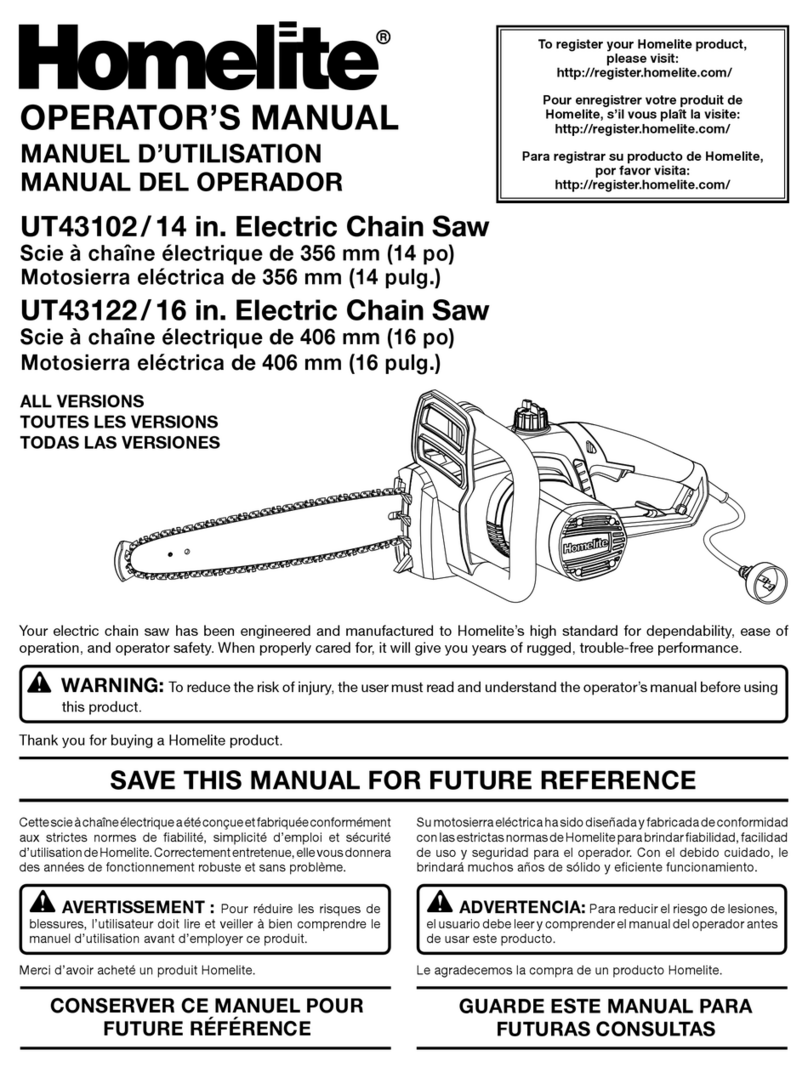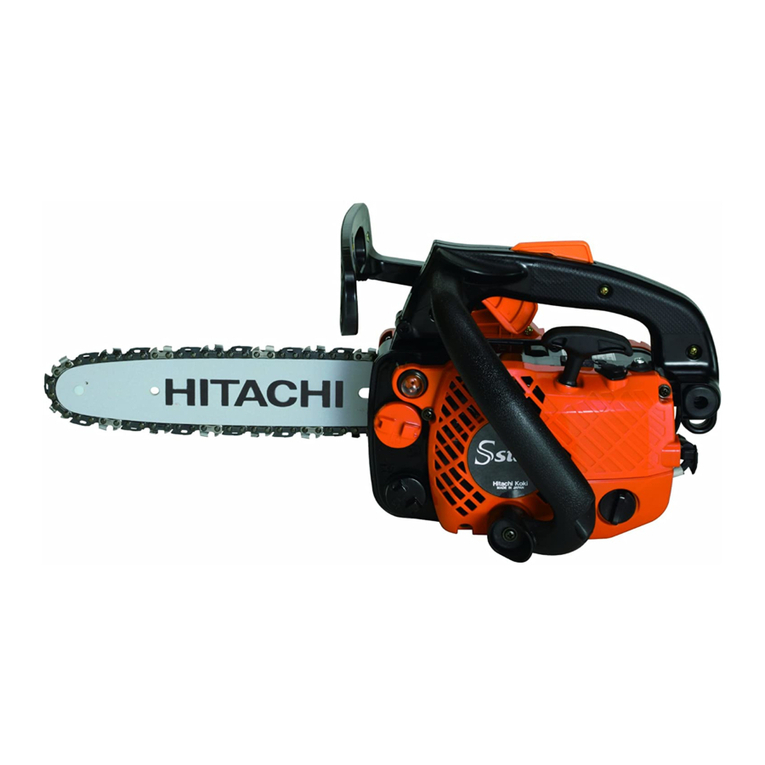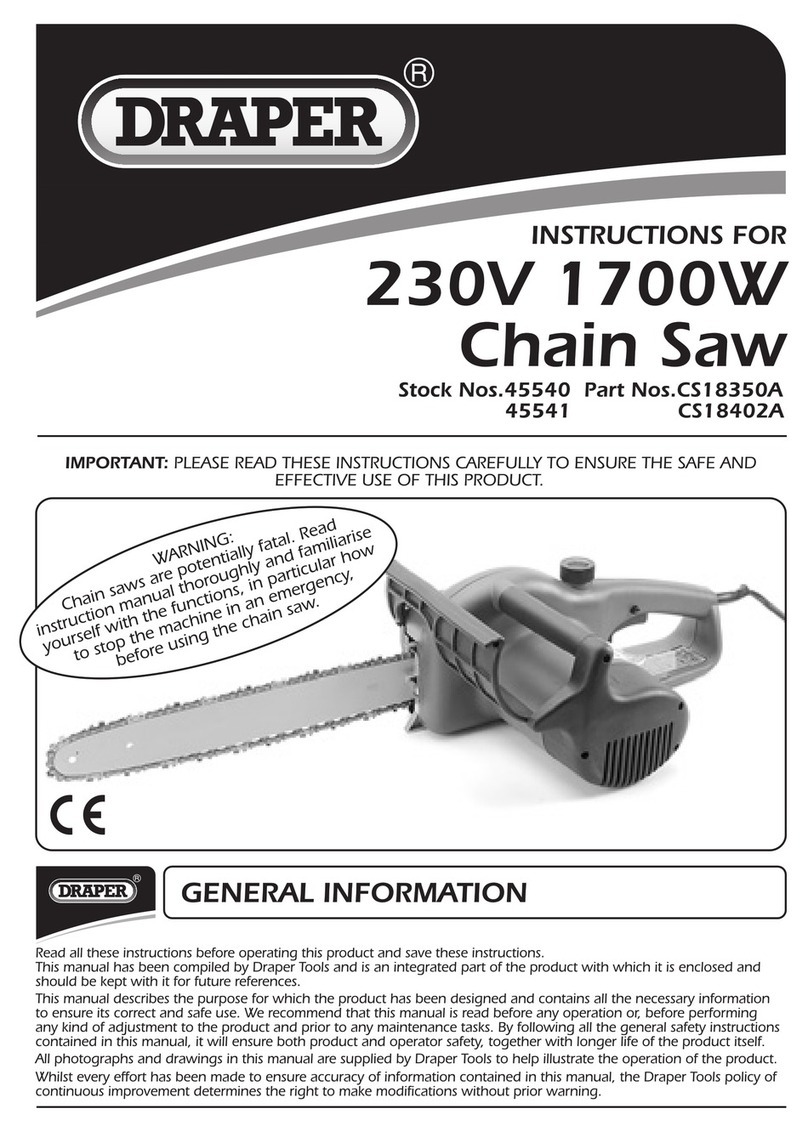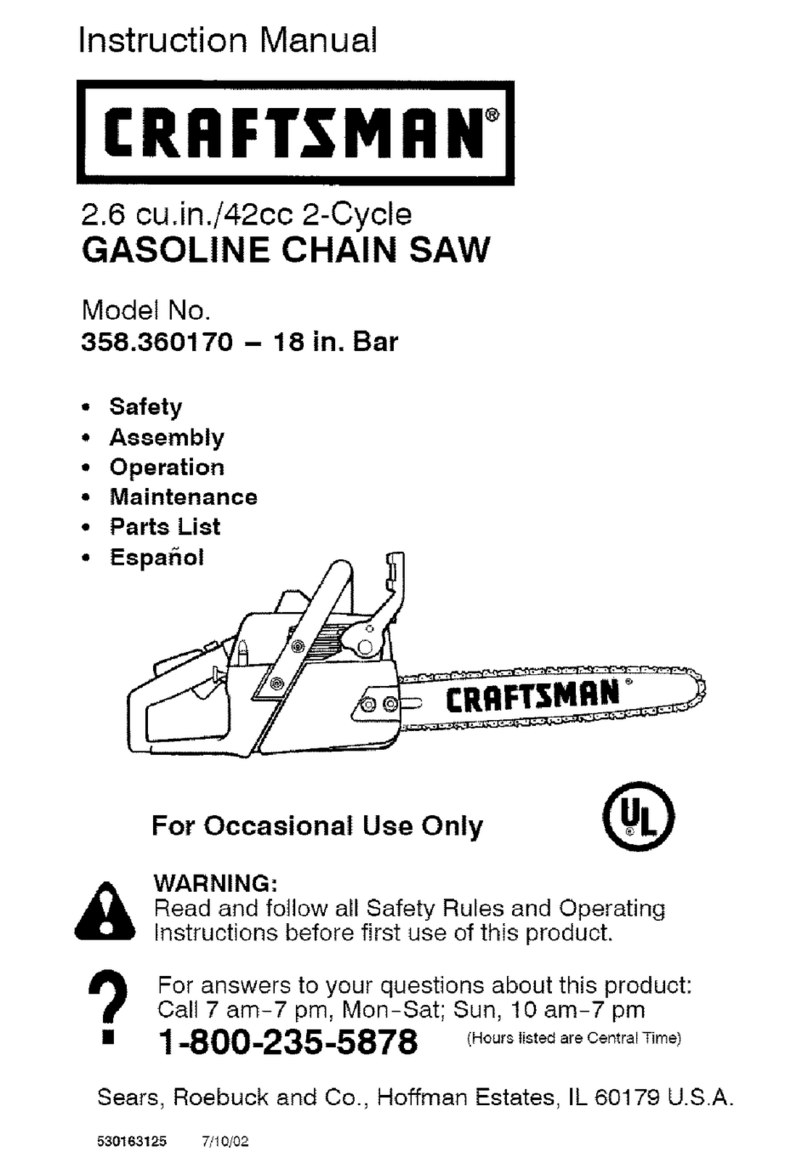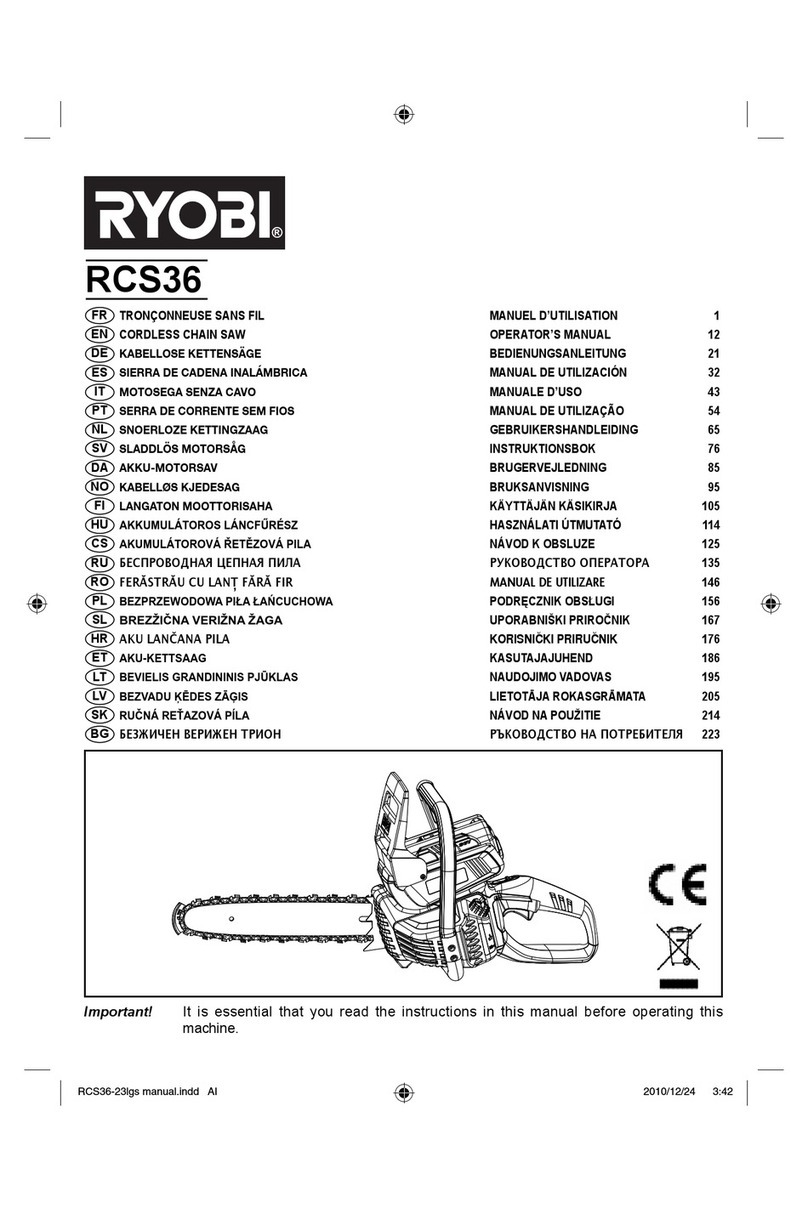Cutters Edge CE94CRS User manual


1
INTRODUCTION
This manual outlines the maintenance and operation of Cutters Edge manufactured products.
The CE94CRS concrete rescue saw is designed to cut concrete, stone, and masonry when used with the appropriate
genuine diamond chain.
To get the maximum benefit from your saw, and ensure maximum safety, be sure to read this manual thoroughly, and
periodically review safety instructions.
TABLE OF CONTENTS
SYMBOLS & LABELS 2
GENERAL SAFETY PRECAUTIONS 4
TECHNICAL DATA 5
SET-UP 6
OPERATION 9
MAINTENANCE 13
TROUBLESHOOTING 19
REFERENCE 20
WARRANTY 21

2
SYMBOLS & LABELS
THE FOLLOWING SYMBOLS & DEFINITIONS ARE FOUND THROUGHOUT THIS MANUAL AND ARE
DESIGNED TO MAKE YOU AWARE OF POTENTIAL HAZARDS OR UNSAFE PRACTICES.
A potentially hazardous situation exists which, if not avoided, could result
in death or serious injury.
A potentially hazardous situation exists which, if not avoided may result in
minor or moderate injury or property damage.
A potential situation exists which, if not avoided, may result in
product or property damage.
THE FOLLOWING SYMBOLS & LABELS MAY BE FOUND IN THIS MANUAL OR ON THE SAW
Read the operator’s manual carefully and understand the
contents before you use this equipment.
Always use:
•Protective helmet
•Ear Protection
•Protective glasses or full face protection
Wear hand protection

3
A potentially hazardous situation exists which, if not avoided, could result
in death or serious injury.
Chain breakage can result in high-speed ejection of parts, which can result in death or serious
injury to operators or bystanders. The items listed below are critical to minimizing the risk of
chain breakage and injury.
•DO NOT operate a concrete chain saw with a damaged, modified, broken, or missing side
cover, bottom guard, or guard flap. The side cover, bottom guard, and guard flap provides
protection against contact with moving parts, ejected debris, broken diamond chain,
thrown water and concrete slurry.
•DO NOT operate saw with loose, missing, damaged or improperly repaired parts.
•DO NOT insert saw into a slot narrower than the chain segments. Rapid pushback might
occur. Reference: Most diamond segments are .225 inches (5.72 mm) wide.
•DO NOT use damaged, modified or improperly repaired chain.
•DO NOT run saw upside-down. Concrete debris can fly back into the operator’s face.
•DO NOT cut ductile iron pipe with the concrete chain saw. Segment loss or diamond chain
breakage may occur.
A potentially hazardous situation exists which, if not avoided may result in
minor or moderate injury or property damage.
•Always turn a concrete chain saw OFF when performing maintenance on the saw including
chain tensioning.
•Never use equipment that is not functioning properly.
•Have the saw repaired only by qualified service personnel.
•Turn engine OFF before refueling. Keep away from open flame. Always provide adequate
ventilation when handling fuel. Move saw at least 10 feet (3 m) away from refueling area
before starting.
•Diamond chains require a minimum water pressure of 50 psi (3.5 Bar). Insufficient water
supply may result in excessive wear to the chain, which can lead to loss of strength and
chain breakage, and/or damage to the guidebar nose sprocket.
•Never start saw unless the bar, chain and side cover are properly installed.

4
GENERAL SAFETY PRECAUTIONS
•Always wear protective clothing, including hard hat, eye protection, hearing protection,
and gloves.
•Avoid loose fitting clothing.
•Perform safety checks before starting each day.
•Always operate tool with solid footing and with both hands on the saw.
•Remove or control slurry to prevent slippery conditions while cutting.
•Be sure there are no obstructions (plumbing, electrical conduit, air ducts) and no
unnecessary people present.
•Set up a well-marked safety zone with a roped boundary and clear signs.
•Provide adequate ventilation when working in an enclosed area. Breathing exhaust gases is
dangerous.
•To avoid electrocution, check for live electrical wiring near cutting area.
A potential situation exists which, if not avoided, may result in product or
property damage.
Note: The concrete chain saw is equipped with a 2-cycle engine and must always be run using a mixture
of gasoline and Cutters Edge 2-cycle engine oil, or other high quality 2-cycle oil that has been formulated
for air cooled power equipment. It is important to accurately measure the amount of oil to be mixed to
ensure that the correct mixture is obtained. When mixing small amounts of fuel, even small inaccuracies
can drastically affect the ratio of the mixture.
•This engine is designed to be operated on premium unleaded gasoline.
•Use high quality, unleaded gasoline with a minimum octane rating of 90. If lower octane gasoline
is used, engine temperature will increase which can result in a piston seizure and damage to the
engine.
•Fuel mixture: 100:1 Cutters Edge or 25:1 petroleum based oil – gasoline/oil mixture. Incorrect
fuel mixture is the number one cause of piston seizure.
•Use Cutters Edge brand 2-cycle engine oil, or other high quality 2-cycle oil that has been
formulated for air cooled power equipment.
•Never use 2-cycle oil formulated for water-cooled 2-cycle engines, such as outboard motor oil.
•Never use motor oil intended for 4-stroke engines.
ENGINE BREAK-IN
•It is very important to break-in a new engine to “seat” all moving parts, especially the piston
rings.
•To break-in the engine, run one full tank of 100:1 fuel at idle, cycling the throttle every 5 to 10
minutes to prevent loading.
•Failure to break-in an engine may result in piston seizure.

5
CE94CRS TECHNICAL DATA
Engine Type 2-stroke, Air Cooled
Displacement 5.7 cu-in (94 cc)
Horsepower 6.4 hp (4.8 kW) @ 9000 rpm
Torque 50.4 in-lbs (5.7 Nm) @ 7,200 rpm
Engine Speed 9,300 +/- 150 rpm (max)
2,700 +/- 100 rpm (idle)
Weight 22.25 lbs (10.1 kg) powerhead only
Dimensions
18 in (46 cm) length
14 in (36 cm) height
13 in (33.02 cm) width
Air Filter Water resistant polyester
Carburetor Walbro RWJ-5A
Starter Dust and water resistant
Ignition Momentary contact on/off switch
Clutch Centrifugal, three shoe, three spring
Fuel Ratio 100:1 Cutters Edge synthetic 2-cycle Oil
Fuel Capacity 0.26 gallon (1 liter)
Water Supply Minimum 50 psi
Water Flow Minimum 2.5 gpm
Noise Level 106 dB(A) at 3 ft (1 m)
Vibration Level 3.9 m/s (front handle)
4.1 m/s (rear handle)
Engine Break-in Period One tank, without cutting, cycling throttle
Spark Plug NGK BPMR7A OR Champion RCJ6Y
Electrode gap 0.020 in (0.5 mm)
Available Bar Lengths
12 inch (30.48 cm)
14 inch (35.56 cm)
16 inch (40.64 cm)
Cutting Depth for Each Length
12 inch (30.48 cm)
14 inch (35.56 cm)
16 inch (40.64 cm)


7
STEP 5
Make sure that all the drive links are inside the
guidebar groove then lift the bar nose and
tension the chain by turning the screw clockwise.
STEP 6
Before cutting, check for proper tension by
pulling the chain around the bar by hand. If you
cannot easily pull by hand, the chain is too tight
and needs to be loosened slightly. CAUTION:
Be aware that the guidebar rails may develop
sharp edges over time so always pull the
diamond chain by the diamond segments.

8
STEP 7
Continue to lift up on the nose of the guidebar
and firmly tighten the side cover nut.
NOTE: To prevent chain tensioner breakage, be
sure the side cover nut is tightened to
approximately 20-25 ft-lbs (27-33 Nm).
STEP 8
Attach to water source with pressure of not less
than 50 psi (3.5 Bar).

9
OPERATION
FUEL HANDLING
FUEL MIXTURE: 100:1 Cutters Edge synthetic 2-cycle oil gasoline/oil mixture.
GASOLINE
OIL
US Gallon
US FL oz.
1 1.3
2 1/2
3.2
5 6.4
GASOLINE
OIL
Liters
ml
1 10
5
50
10 100
20
200
•Use premium unleaded gasoline with a minimum octane rating of 90. If lower octane gasoline is
used, engine temperature will increase which can result in a piston seizure and damage to the
engine.
•Always provide adequate ventilation when handling fuel.
•Use caution when handling gasoline. Avoid direct contact with skin or inhaling fuel vapor.
FUEL MIXING
•Always mix gasoline and oil in a clean container intended for use with fuel.
•Keep fuel container closed tightly to prevent moisture from getting into the fuel.
•Always begin mixing fuel by adding half the amount of gasoline to be used. Then add the correct
amount of 2-cycle oil for 100:1 (1%) mixture and finish filling the container with gasoline.
•Do not mix more than one month’s supply of fuel. This helps prevent the separation of the 2-cycle
oil from the gasoline (varnishing).
•If the saw is not used for an extended period of time (3 months) the fuel tank should be emptied
and cleaned.
FUELING
•Always shut off the saw before fueling.
•Before fueling, clean the area around the fuel cap to prevent dirt from contaminating the fuel.
Contamination of the fuel tank can lead to saw malfunction.
•Thoroughly mix the fuel in its container before fueling.
•Slowly open the fuel cap to release any pressure that may have built up in the tank.
•After adding fuel, tighten the fuel cap carefully and secure with a wrench.

10
STARTING AND STOPPING A CONCRETE CHAIN SAW
Never start a concrete chain saw without the bar, chain and side cover
properly assembled. Failure to do so may result in serious injury.
Always move a concrete chain saw at least 10 feet (3 m) away from fueling
area before starting.
Place the saw on clear ground. Ensure that secure footing is established and
chain is not contacting any objects.
COLD ENGINE STARTING PROCEDURE
1. Pull the choke lever out, which also sets the throttle lock.
2. Depress primer bulb approximately 5-10 times.
3. Push in decompression valve.
4. Open the water valve ¼ turn.
5. Place the saw on stable ground making sure the chain is free of any obstructions.
6. Place foot on the base of the rear handle, and place one hand on front handle.
7. With opposite hand, slowly pull starter handle until the starter pawls engage.
8. Pull the starter cord (hard, fast, short pulls) until engine initially fires or “pops”. Could be as many
as 10-15 pulls.
9. Push the choke lever in.
10. Pull the starter cord until engine starts – should be 1 to 2 pulls.
11. Release the throttle lock by momentarily squeezing on the throttle trigger.
12. When the engine starts, allow the engine to idle briefly. Squeeze the throttle trigger several times
to help warm up the engine.
13. Open the water valve completely.
WARM ENGINE STARTING PROCEDURE
1. Use the same procedure as starting a cold engine, but pull choke lever out, and then push back in
to set the throttle lock. If choke is used on a warm engine, the carburetor will flood with gas.
2. If the engine does not start in 3 hard, fast pulls with the throttle locked, fully squeeze and hold the
trigger while pulling the starter cord 3 more times.
NOTE: To hold the trigger fully open it may be necessary to insert right foot into rear handle
opening and twist.
STOPPING THE SAW
•To turn the engine off, push stop switch to the ‘STOP’ position. Close water valve.

11
PRE-CUT CHECKLIST
•Ensure proper chain tension: The chain should be easily pulled around the guidebar by hand.
•Ensure all safety devices are properly mounted and functional and that all controls are in proper
working order.
•Be sure there are no obstructions (plumbing, electrical conduit, air ducts) and no unnecessary
people present.
•Always wear protective clothing, including hard hat, eye protection, hearing protection, non-slip
safety boots, and gloves. Avoid wearing loose clothing.
•Adequate water supply and pressure:
Minimum flow: 2.5 gpm (9.5 lpm)
Minimum water pressure: 50 psi (3.5 bar)
•Diamond chains require a minimum water pressure of 50 psi (3.5 bar).
The single most important factor an operator can control to increase chain
life is to use adequate water pressure. Insufficient water supply will result in
excessive wear to the chain, which can lead to loss of strength and chain
breakage, and/or damage to the guidebar nose sprocket.
PLANNING THE CUT
•Select the proper chain type for the material being cut.
•Outline the cut with a permanent marker for visual cutting guide.
•Avoid pinching the guidebar and chain. Always cut the bottom of an opening first, then top, and
then the sides. Save the easiest cut for last.
•For the straightest cuts use the “Step Cut” method. First score the entire cut line approximately a
half-inch deep using the nose of the bar. Next, deepen the cut by about two inches. Then plunge
all the way through and complete the cut using the Wall Walker.
•Be sure cut concrete cannot fall and injure operator or bystanders. Concrete is very heavy, one
cubic foot = 12 in x 12 in x 12 in = 150 lbs (30 cm x 30 cm x 30 cm = 68 kg).
•Check for and remove any obstructions (plumbing, electrical conduit, air ducts, etc,) that may
interfere with the cut.
CUTTING WITH THE CE94CRS
To start a cut, hold trigger on full throttle and slowly plunge the nose of the bar straight into the wall.
Lengthen the cut and engage the point of the Wall Walker.

12
CUTTING TIPS
•Always operate the concrete chain saw at full throttle. If too much force is applied, the saw will
lug or stall. The chain will not have enough speed to cut effectively. If too little feed force is
applied, the diamonds will skid and glaze over.
•For straighter cuts use the “Step Cut” method. First score the entire cut line with the nose of the
guidebar approximately ½ in (12 mm) to 1 in (25 mm) deep. Next, deepen the cut by about 2 in
(50 mm). This groove will help guide the guidebar for a straight cut. Then plunge all the way
through and complete the cut using the Wall Walker.
•Plunge cut instead of starting at the top surface of the wall. This will reduce chatter, extend
diamond life, create a straighter cut and more quickly enable the use of the Wall Walker.
USING THE WALLWALKER®
•To use correctly, make the initial plunge cut and cut downward an inch or two to open the length of
the cut to accept the Wallwalker®. Engage the point of the Wallwalker® into the cut and push
straight in (forward), wedging the Wallwalker® point into the cut.
•As you continue to push the saw forward into the cut, the Wallwalker® will begin to rotate up and
feed force will develop downward along the line of the intended cut. While you are pushing the saw
forward and the Wallwalker® is rotating up, the upward action of the Wallwalker® will begin to
force the back handle of the saw down. Pull the back handle of the saw upward to counter the
downward force and keep the saw perpendicular to the material being cut, otherwise the Wallwalker®
point could skid and slip, which will reduce its effectiveness.
•Once the Wallwalker® is fully rotated upwards, pull the saw out of the cut a few inches. The
Wallwalker® point will snap back to its original position and you can re-engage the point of the
Wallwalker® back into the cut and continue to cut and repeat.
•When cutting heavy rebar, slowly “rock” the saw so that you’re always cutting concrete as well as
steel. This will help keep the diamonds exposed. Also, expect less chain life when cutting heavy
rebar.
•Expect more chain stretch when making nose buried cuts for extended periods of time, as the
chain does not have a chance to “throw” the slurry away from the nose of the bar.
•If the saw begins to cut consistently crooked, turn the bar over and use the other side. Dress worn
rails with belt sander. NOTE: The normal life of a guidebar is two to three diamond chains.
Heavy rebar can shorten guidebar life.
•Remove bar and chain. Flush out the chain tensioner and side cover with water. Lubricate
tensioner with grease.
•After cleaning the saw, spray the entire saw body, chain, bar, and drive sprocket with lightweight
oil. Using silicone spray or WD40 on the saw will minimize rust and help reduce slurry build up.
The Wallwalker® is a high efficiency device designed to create a mechanical
advantage and feed force. As the operator pushes the saw forward into the
material being cut, the upward pivoting action of the Wallwalker® forces the saw
downward creating a mechanical advantage. Use the Wallwalker® to cut
efficiently and reduce fatigue.
The Wallwalker® is a lever system that converts forward force to downward
force and will develop a 4-to-1 mechanical advantage.

13
SYSTEM CLEAN-UP
•After cutting, run the saw for at least 15 seconds with the water on to flush slurry and debris from
chain, bar and drive sprocket.
•Wash concrete slurry from saw assembly.
•Avoid getting any water in the carburetor or exhaust system. If water enters exhaust port, point
the bar tip down and pull the starter handle several times to expel water from muffler.
MAINTENANCE
Follow these simple maintenance guidelines
and your saw will continue running at its very best.
AFTER EACH USE
1. Rinse the saw, guidebar and diamond chain with water.
2. Inspect and tighten all fasteners as necessary.
3. Inspect, flush and grease the chain tensioner.
4. Inspect drive sprocket for wear. Replace if tooth tips are pointed, or if groove cuts through top of
tooth.
5. Check clutch cup needle bearing for wear. Ensure clutch cup spins freely and without excessive
play.
6. Check starter cord for wear or damage. Replace as necessary.
7. Inspect air filter. Replace filter if dirty.
8. Spray saw, guidebar, and chain with silicone or WD40.
9. Spray silicone or WD40 into the air intake slots on the starter housing to keep starter pawls from
sticking.
AFTER 10 HOURS OF USE
1. Remove the starter cover and clean the flywheel fins and the starter pawls with a wire brush, and
then grease the starter pawls.
2. Remove the spark plug and clean with a wire brush. Check the electrode gap. The correct gap is
0.020 inches (0.5 mm).
3. Grease the clutch cup needle bearing.
AFTER 40 HOURS OF USE
1. Change the spark plug. Adjust the electrode to 0.020 inches (05. mm).
2. Check the fuel filter located inside the fuel tank. Clean or replace if clogged.

14
AIR FILTER
The polyester air filter must be kept clean for the engine to operate properly.
If the saw is not reaching full RPM, most likely the air filter is dirty.
•The air filter should be free of holes and
white in color.
•Replace air filter when dirty.
•When replacing the air filter, clean the
area inside the air intake housing with a
clean rag prior to installing new filter.
STARTER HOUSING ASSEMBLY
It is common for concrete slurry to get inside the starter housing assembly
during cutting. This can cause the starter pawls to stick and not engage
when the rope is pulled.
•After each usage, thoroughly flush the
starter housing assembly with water.
•Oil the starter pawls by spraying silicone
or WD40 into the starter housing through
the vents.
•Check the starter cord for fraying,
replace if necessary.

15
STARTER ROPE REPLACEMENT
•Loosen the four screws that attach the
starter cover assembly to the crankcase,
and remove the starter cover assembly
from the saw.
•Pull cord out from pulley approximately
12 inches (30 cm) and hook rope into the
notch in the pulley. Relax the recoil
spring by placing thumb on the pulley
and gently allow the pulley to rotate
backwards to unwind the spring entirely.
•Remove the old starter rope through the
hole in the starter housing and then
through the hole in the pulley.
•Wrap the starter rope around the raised
center of the pulley, looping over top and
under the beginning of the wrap. Tighten
the knot firmly and ensure that free end
of rope is as short as possible. Secure the
other end of the rope in the starter
handle.
TENSIONING THE RECOIL SPRING
•Hook the rope in the notch of the pulley and wind the rope clockwise three times around the
raised center of the pulley.
•Pull the starter rope with the handle until the rope is unwound, tensioning the spring. Repeat this
process, but this time wind the rope clockwise four times around and then pull the rope with the
handle to complete the tensioning of the spring.
NOTE: When released, the starter handle should be drawn to the correct start position after tensioning
the spring.
CAUTION: Check that the pulley can be turned an additional ½ turn when the starter cord is pulled all
the way out.
STARTER HOUSING ASSEMBLY
•To reattach the starter cover assembly,
first pull the starter cord out, and then
hold the starter housing against the
crankcase. Slowly release the starter cord
to enable the pulley to fit between the
pawls.
•Insert and tighten screws. Use Red
Loctite® #268.

16
CHAIN TENSIONER
The chain tensioner can become clogged with concrete slurry during cutting.
After each use thoroughly flush the chain tensioner with water and apply a
liberal amount of grease.
NOTE: The chain tensioner is located on side
cover, to the outside of the guidebar.
Most common causes of tensioner damage:
•Side cover nut is not tight enough. Side
cover nut should be torqued to 20-25 ft-
lbs (27-33 Nm).
•Chain tensioning is attempted without
loosening the side cover nut.
•Concrete debris in tensioner pocket.
DRIVE SPROCKET
The drive sprocket (rim sprocket) is a wear item and should be replaced
after two to three diamond chains have been used, or when drive teeth
become pointed.
The needle bearing inside the splined adapter should be greased regularly
and should be replaced with each new clutch cup.
A drive sprocket system consists of a clutch cup w/ splined adapter and a drive sprocket. When the drive
sprocket wears out, it is the only part that needs to be replaced. The clutch cup with splined adapter is a
wear item that needs replacement after 3 to 5 drive sprockets have been used.
•Inspect the drive sprocket for wear.
Replace the drive sprocket if the drive
teeth become pointed.
•Check the needle bearing inside the
splined adapter by spinning the clutch
cup. Ensure clutch cup spins freely and
without excessive play.
•The needle bearing must be greased
regularly, use high quality water-
resistant bearing grease.

17
DRIVE SPROCKET REMOVAL
•Remove the side cover, guidebar and
diamond chain.
CAUTION: Wear safety glasses.
•Using a screwdriver, carefully pry the
spring clip from the half collars.
TIP: Cup your hand over the end of the
shaft to prevent the spring clip from
being ejected.
•Remove the half collars and retaining
washer from the shaft.
•Slide the drive sprocket off of the splined
adapter.
DRIVE SPROCKET INSTALLATION
•Prior to installing a new drive sprocket,
slide the clutch cup off of the shaft and
apply high quality water-resistant grease
to the needle bearing.
•Reengage the clutch cup onto the shaft
and slide the drive sprocket onto the
splined adapter, either side out.
•Install the retaining washer and half
collars onto the shaft.
•Place the spring clip atop the half collars,
ensuring the half collars are symmetrical
with equal gap on either side.
•Engage the spring clip onto the half
collars by firmly pressing down with a
screwdriver over the top of one of the
gaps. TIP: Hold your thumb on the
spring clip over the opposite side gap to
maintain placement.
•Once the spring clip is partially engaged
on one side, perform the same technique
to the other side, again pressing firmly
over the top of the gap.
•Check proper spring clip engagement by
carefully prying out on the half collars.
Both half collars should be firmly secured
to the shaft.

18
SPARK PLUG
•A worn or fouled spark plug can cause a
loss of power, difficulty starting or rough
idle.
•If the spark plug is dirty, clean it with a
wire brush and check the electrode gap.
Readjust if necessary. The correct gap is
.020 inches (0.5 mm).
•The spark plug should be replaced after
40 hours of operation or earlier if the
electrode is badly corroded.
•Always use the recommended spark plug
type. Using the wrong spark plug can
severely damage the piston and cylinder
(NGK #BPMR7A).
CARBURETOR
•The function of the carburetor is to mix
fuel with air. Adjustments other than idle
speed should only be made by a servicing
dealer.
•Before adjusting the engine idle speed,
make sure the air filter is clean and the
engine is warmed up.
•Idle screw is adjusted so that the engine
idles smoothly but the clutch does not
engage.
•If saw has been running satisfactorily and
there is a gradual decrease in power and
drop in RPM at full throttle, the filter
may have become dirty or saturated with
water.
GUIDEBARS
•The bar is designed to be used on both sides. If the cut is consistently leading to one side, turn the
bar over to expose a new set of rails.
•A table mounted belt or disc sander can be used to square the rails of a worn bar. A badly worn
bar can quickly damage an expensive chain. If the chain is touching the bottom of the bar groove,
replace the bar.
•Check the guidebar for straightness.
•Proper chain tension will extend bar life. See page 7.
•Under some circumstances, especially low water pressure, the sprocket nose can wear out before
the guidebar body. Sprocket nose replacement kits may be purchased from an Authorized Dealer.
•Spray the chain and bar with silicone or WD40 for storage.
•Store bar with the sprocket nose up.
•Periodically clean the water ports inside the groove of the bar using a small diameter piece of wire.
•The bar is solely a guide track for the chain. Never use the bar to lift, twist or pry concrete
material.

19
TROUBLESHOOTING
PROBLEM POSSIBLE CAUSE
SAW WON'T REACH FULL
RPM Dirty air filter
SLOW DIAMOND CHAIN SPEED
Chain tension too tight. Diamond chain should always be able to be
pulled around the guidebar by hand. It is normal for the diamond
chain links to hang below the guidebars.
POOR CUTTING SPEED Diamonds may be glazed over. Make a few cuts in an abrasive
material to expose the diamonds.
PREMATURE CHAIN STRETCH
Not enough water pressure. The minimum water pressure required
is 50 psi (3.5 bar). Insufficient water supply may result in excessive
wear to the diamond chain, which can lead to loss of strength and
diamond chain breakage.
CHAIN TENSIONER BREAKAGE Side cover nut is not tight enough. Torque to 20-25 ft-lbs (27-33Nm).
WATER NOT FLOWING
Water hose is kinked or water supply not turned on.
Water ports plugged with debris.
WON'T START
Aged or bad fuel.
Defective spark plug.
DIFFICULT TO START
Flooded engine. Push choke in, hold throttle on full with foot and
pull starter cord (hard, short, fast pulls) until engine starts.
Fouled spark plug. Remove spark plug, clean, and re-gap to .020 in
(0.5 mm).
DIAMOND CHAIN BREAKAGE
Improper chain tension.
Inserting saw into slot narrower than diamond chain segments.
Not enough feed pressure while cutting. Avoid letting the saw
bounce and chatter.
Further questions?
Call 1-800-433-3716 or visit our website at cuttersedge.com
Table of contents
